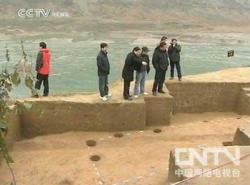- 22 MARS
- FRANCE –  Chauvigny - Une fouille autour des vestiges de la Porte des Tours a permis de révéler des structures enfouies, dans le prolongement des ruines visibles aujourd'hui. Un sondage a été effectué autour des vestiges d'une porte monumentale, nommée depuis le XIX e siècle « Porte des Tours », donnant sur la rue des Trois-Rois, à quelques mètres de l'entrée du château baronnial, possession des évêques de Poitiers. Cette porte, se présentant sous la forme de deux piliers plus ou moins cylindriques, a pu être identifiée comme correspondant vraisemblablement à une porte mentionnée dans des sources historiques de la seconde moitié du XV e siècle, alors connue sous le nom de '' Porte des chanoines - La fouille archéologique proprement dite a été effectuée au pied du montant oriental de cette porte, donnant sur le jardin d'inspiration médiévale de Chauvigny, afin de déterminer si cette porte se prolongeait éventuellement par une muraille appartenant à l'enceinte de la ville haute. D'étendue relativement limitée en raison des aménagements du jardin public, le sondage a néanmoins permis de révéler des structures enfouies, dans le prolongement des ruines actuellement visibles. Il a ainsi été mis au jour plusieurs rangées de pierres dans l'axe du pilier formant un angle perpendiculaire qui, semble-t-il, devrait correspondre à l'arrière du pilier. Quelques tessons calés entre les pierres pourraient confirmer une datation médiévale de cette structure. » - Grâce à ce sondage, l'éventualité d'une muraille prolongeant cette porte est désormais sérieusement mise en doute. Il nous permet également de réévaluer le rôle éminemment symbolique de cette porte, précédant et annonçant l'entrée autrefois monumentale du château des Évêques - Une nouvelle fouille est prévue pour vérifier si le jardin du musée est une motte féodale ou plus tardive, et pour réaliser des sondages sur des sections d'enceintes.
Chauvigny - Une fouille autour des vestiges de la Porte des Tours a permis de révéler des structures enfouies, dans le prolongement des ruines visibles aujourd'hui. Un sondage a été effectué autour des vestiges d'une porte monumentale, nommée depuis le XIX e siècle « Porte des Tours », donnant sur la rue des Trois-Rois, à quelques mètres de l'entrée du château baronnial, possession des évêques de Poitiers. Cette porte, se présentant sous la forme de deux piliers plus ou moins cylindriques, a pu être identifiée comme correspondant vraisemblablement à une porte mentionnée dans des sources historiques de la seconde moitié du XV e siècle, alors connue sous le nom de '' Porte des chanoines - La fouille archéologique proprement dite a été effectuée au pied du montant oriental de cette porte, donnant sur le jardin d'inspiration médiévale de Chauvigny, afin de déterminer si cette porte se prolongeait éventuellement par une muraille appartenant à l'enceinte de la ville haute. D'étendue relativement limitée en raison des aménagements du jardin public, le sondage a néanmoins permis de révéler des structures enfouies, dans le prolongement des ruines actuellement visibles. Il a ainsi été mis au jour plusieurs rangées de pierres dans l'axe du pilier formant un angle perpendiculaire qui, semble-t-il, devrait correspondre à l'arrière du pilier. Quelques tessons calés entre les pierres pourraient confirmer une datation médiévale de cette structure. » - Grâce à ce sondage, l'éventualité d'une muraille prolongeant cette porte est désormais sérieusement mise en doute. Il nous permet également de réévaluer le rôle éminemment symbolique de cette porte, précédant et annonçant l'entrée autrefois monumentale du château des Évêques - Une nouvelle fouille est prévue pour vérifier si le jardin du musée est une motte féodale ou plus tardive, et pour réaliser des sondages sur des sections d'enceintes.
http://www.lanouvellerepublique.fr/vienne/LOISIRS/Patrimoine-tourisme/Ville-Haute-la-Porte-des-Tours-revele-des-structures-enfouies
- USA – 
 Hopewell - A coin from the late 1700s and a mud-encrusted stirrup unearthed from the bed of Jacobs Creek last week have some locals more convinced than ever that Gen. George Washington and his army traversed the tiny waterway en route to the Battle of Trenton. The items were found during an archeological dig commissioned by a group of local residents trying to get the creek vista added to state and national historic registers as part of a segment of Washington’s historic march to Trenton in 1776.
Hopewell - A coin from the late 1700s and a mud-encrusted stirrup unearthed from the bed of Jacobs Creek last week have some locals more convinced than ever that Gen. George Washington and his army traversed the tiny waterway en route to the Battle of Trenton. The items were found during an archeological dig commissioned by a group of local residents trying to get the creek vista added to state and national historic registers as part of a segment of Washington’s historic march to Trenton in 1776.
http://www.nj.com/mercer/index.ssf/2011/03/jacobs_creek_archeological_dig.html
- ROYAUME-UNI – Wales - A test to show how people in the Iron Age communicated using Welsh peaks was yesterday hailed a success. Scores of volunteers flashed torches to each other from 10 hillforts in North Wales, the Wirral and Cheshire. The furthest link spanned 15 miles, between hills at Burton Point on the Wirral and Cheshire’s Maiden Castle. The experiment was designed to see how easily Iron Age communities could interact from their hilltop homes thousands of years ago. Archaeologist Erin Robinson, from Denbighshire’s heather and hillforts project, said the experiment had captured the public’s imagination. “Most of the hill forts across the surrounding landscape can be seen from each other,” she said. “The experiment was aiming to see if the glowing fires could have been seen across the hills and acted as a communication or warning system. “It was a hard thing to organize, but it seems to have captured the imagination of the communities involved. We brought the hills alive.”
http://www.walesonline.co.uk/news/wales-news/2011/03/21/talking-fires-link-iron-age-hillforts-91466-28372643/#ixzz1HLT7peBf
- USA – North Charleston - After sitting in the same spot for 10 years, the H.L. Hunley is finally ready to move. This summer, the team at the Warren Lasch Conservation Center will take the 19th century submarine out of the lift cradle that’s held it since 2000 and set it upright for the first time since 1864. Since the sub was delivered to Warren Lasch in 2000, archaeologists and conservators have removed several pieces of the sub and emptied it of sediment, crew remains and other artifacts. That has potentially changed the strength of the sub and created new stress points. But computer models show that the plan to slowly inch the sub upright and to the floor of the tank it sits in will work flawlessly. Because the Hunley was taken from the spot where it sank in 1864, that concretion holds the only record of the sub’s 130-plus years on the ocean floor. The concretion also serves as an extra level of strength and protection for the sub, so it’s to the scientists’ advantage to leave it on through the move. But once that’s finished, all the concretion — and evidence recorded in it — will be removed. The Hunley became the first successful combat submarine on Feb. 17, 1864, when it sank the USS Housatonic, a Union blockade ship. Shortly after the attack, the Hunley disappeared. No one knows why. In the meantime, the crew continues to restore the hundreds of artifacts found inside the Hunley. Mardikian just finished work on binoculars that belonged to the sub’s captain, George E. Dixon. They look more like theater glasses than modern binoculars.
http://www.thestate.com/2011/03/21/1744818/scientists-finally-ready-to-right.html#ixzz1HLRLdzEN
- CHINE –  – Gonghe - Experts have found a new relic site of Shang Dynasty dating back to 16th century B.C. The new discovery will help a lot to learn more about the culture of southwestern China and the Wujiang River. The site was found at Gonghe village of Pengshui county in Chongqing Municipality. Nearly 1,000 square meters have been excavated with more than 20 pits. Researchers have discovered 2 tombs, 3 houses and some stoves and kitchens. Along with them are some pestles, an ax made of stone, and a great deal of pottery, iron-vessels and even some animal's teeth
– Gonghe - Experts have found a new relic site of Shang Dynasty dating back to 16th century B.C. The new discovery will help a lot to learn more about the culture of southwestern China and the Wujiang River. The site was found at Gonghe village of Pengshui county in Chongqing Municipality. Nearly 1,000 square meters have been excavated with more than 20 pits. Researchers have discovered 2 tombs, 3 houses and some stoves and kitchens. Along with them are some pestles, an ax made of stone, and a great deal of pottery, iron-vessels and even some animal's teeth
http://www.kaogu.cn/en/detail.asp?ProductID=2744
- CHINE – Guangdong - Thirteen professionals have arrived at the Maritime Silk Road Museum of Guangdong Province and are preparing for the second indoor trial excavation of the sunken vessel "Nanhai No. 1," according to announcement made by the museum on March 21. The excavation is expected to last for around one month. The second trial excavation will be carried out on the bow and stern of the ship and will verify which end is indeed the bow and stern. According to sources, the excavation will further perfect the indoor underwater archaeological parameters and make preparations for the full excavation plan. The first trial excavation of the "Nanhai No. 1" was conducted between Aug. 18 and Sept. 27 in 2009. The location of the first trial excavation was in the middle part of the ship where there were four square excavation units with an area of 4 square meters each. The first trial excavation uncovered more than 200 pieces of porcelain and met the expected targets. The "Nanhai No.1," which sank during the Southern Song Dynasty, is 30.4 meters long and 9.8 meters wide. It is the earliest, largest and most intact ocean trade shipwreck that has been discovered in the world and contains a massive amount of historical information. Archaeological experts said it will take at least five to 10 years to sort out the 60,000 to 80,000 antiques after opening the sunken cases in the shipwreck.
http://english.peopledaily.com.cn/90001/90776/90882/7327831.html